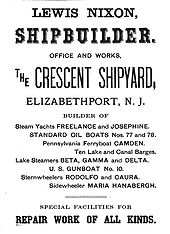- Crescent Shipyard
-
Crescent Shipyard, located in Elizabeth, New Jersey, built a number of ships for the United States Navy and allied nations as well during their production run, which lasted about ten years while under the Crescent name and banner. Production of these ships began before the Spanish-American war and occurred far before the outbreak of World War I. Arthur Leopold Busch, a recent emigre from Great Britain, started the yard with former Navy Lt. Lewis Nixon in January 1895. Both men previously worked for William Cramp & Sons in Philadelphia. Both Nixon and Busch were regarded to be amongst the best in their respected fields - and what they did at this time - as designers and builders of the latest, most advanced types of ships.[citation needed]
Busch, as this shipyard's superintendent, supervised several classes of naval ships including gunboats, monitors, and cruisers in addition to the first commissioned submarine of the United States Navy, USS Holland (SS-1). The Holland is considered to be technologically revolutionary in several respects.[citation needed] This submarine was considered a historic first, and revolutionary in a timeline of naval innovations in world history. Internationally, many "advanced" industrialized nations around the world took note... almost immediately - and some acquried the rights to build them soon after the purchase of the Holland VI on 11 April 1900.
Busch, as shipyard construction chief and naval architect for Lewis Nixon, went on to supervise the building of the prototype "Fulton", which followed the USS Holland and was used as an example and template in development of America's A-class or Adder-class submarines. Busch reviewed the engineering plans of Fulton with Holland, who approved the works of Busch.[1] These pioneering submarines were built for the Holland Torpedo Boat Company named after this company's founder John Philip Holland. Work on these submarines began at this shipyard in the late fall of 1896 with the keel to the Holland VI being laid down by early December of that year.
Holland's company evolved into the Electric Boat Company after this company was officially incorporated on 7 February 1899. Japan's first five submarines were developed under Busch's direction while working at Fore River Ship and Engine Company in Quincy, Massachutsetts for Electric Boat and Admiral Francis T. Bowles, President of the shipyard in 1904. Electric Boat had subcontracted with the Fore River Shipbuilding yard for some twenty years (since this time) before moving to their present location in Groton, CT.
Nixon, a cofounder of Crescent Shipyard was also the lead designer of America's first class of battleships at William Cramp and Sons Shipyard, in Philadelphia.
Isaac Rice's Electric Launch Company, which was started to build electrically propelled launches and small craft, also began its operations here.
References
- ^ "SS-2 A-1 Plunger". GlobalSecurity.org. http://www.globalsecurity.org/military/systems/ship/ss-2.htm.
- Morris, Richard Knowles (October 1998). "Who Built Those Subs?". Naval History (United States Naval Institute) 12 (5). ISSN 1042-1920. OCLC 16311980.
- Grant, Tina; Thomson Gale; Gale Group (July 2007). International directory of company histories. Volume 86. Detroit: St. James Press. pp. 136–139. ISBN 9781414429700. OCLC 162121043.
External links
- Mitchell, Robert; Dembek, Stephen (2001-03-03). "Submarine Pioneers". Chief of Naval Operations, Submarine Warfare Division, United States Navy. http://www.navy.mil/navydata/cno/n87/history/pioneers3.html#Frank%20Cable. Retrieved 2008-02-12.
- History of the Crescent Shipyard from ColtonCompany.com
- John Philip Holland and His Submarines
- Crescent Shipyard information at GlobalSecurity.org
- [1] Another account of the United States Navy's first fully commissioned submarine USS Holland SS-1 purchased on 11 April 1900 for $150,000.
- More detailed account of Holland's submarines including the proto-type Fulton.
Categories:- 1895 establishments
- Elizabeth, New Jersey
- Companies based in Hudson County, New Jersey
Wikimedia Foundation. 2010.

